This was published 8 years ago
Orang-utan trekking in Sumatra, Indonesia: In search of the Sumatran orang-utan
Chris Johnston takes his family on a trek through the Sumatran jungle in search of the orang-utan.
By Chris Johnston
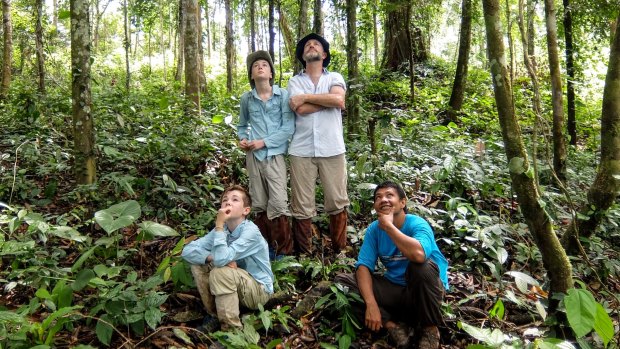
Seeing Orangutans in the wild with jungle guide Udin. Pictured, clockwise from back left, Tom, Chris, Udin and Kit.Credit: Penny Stephens
We are on an eight-hour minivan drive out of Medan, ramshackle capital of the Indonesian island of Sumatra. We're heading north-west towards Aceh province to a mountainous national park. Soon enough I would wake up in the jungle with a leech in my throat, on its way towards my entrails. But first, the longest drive.
You can't fly. We're going to Ketambe in the Gunung Leuser National Park to commune with the orang-utans. There used to be an airport at Kutacane, near Ketambe, with small Susi Air planes, but they don't fly there any more. Even if they did it might not be a great idea. The Travelfish forums on the airline are apocalyptic.
So the only way in is by road and northern Sumatra is very wet and very hot, full of mountains and volcanoes and deep green valleys, and prone to floods. The road is mainly sealed, but in these remote, vulnerable realms 'sealed' is a figure of speech. There is a public bus, but we got a man with a van who came as a package from the eco-tourism/jungle trekking place who were expecting us.
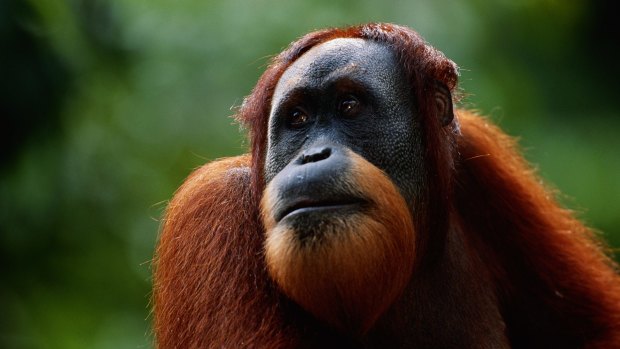
An orang-utan (Pongo pygmaeus) close up in the Gunung Leuser National Park, Indonesia.Credit: Anup Shah
Our kids (aged 12 and ten at the time; two boys) sleep a lot. It is daytime and my partner Penny and I stare out the window as a slideshow of rural Sumatra slid past – mosques, people coming and going from mosques, cornfields, motorbikes and chickens.
For lunch our driver pulls into a Muslim truckstop at a town called Berastagi; the Sumatran method of ordering food is you point at stuff on the counter, they bring what you point at and charge for what you eat. The beef rendang is so tender it is almost air.
Then back on the road for six more hours. Why all the effort? This is not what the guidebooks would call convenient.
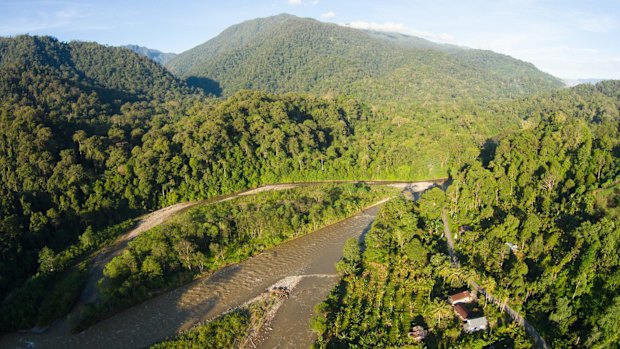
Mount Leuser National Park.Credit: Getty Images
The reason is real wilderness. The orang-utans up near Ketambe are away from palm oil plantations (which are planted in place of natural jungle) and genuinely wild. There are treks closer to Medan but they are heavily touristed with feeding platforms for the orang-utans.
We have come via Singapore and are travelling very light and we feel unburdened and virtuous. Even the books I bring are thin and worthy. We are so full of vaccinations my insides feel like the Sandoz laboratory. Later we visited a secret Indonesian island and also lounged by a pool at a Malaysian resort but for now it's about getting down and dirty in the jungle with the great orange long-haired apes, who only live in Sumatra and Malaysian Borneo. Their name in Malay means 'person of the forest.'
With us we have jungle gear, for the trekking. The jungle gear is all matching by mistake, which is awkward but OK. You need to wear the right stuff or you will be eaten alive, get heatstroke or be cut to shreds. The Gunung Leuser National Park covers 8000 square kilometres. The Alas river cuts through Ketambe in the north of the national park. Its cool, swift waters would become very important in the heart of the jungle the dirtier, sweatier and more infested with leeches we become.
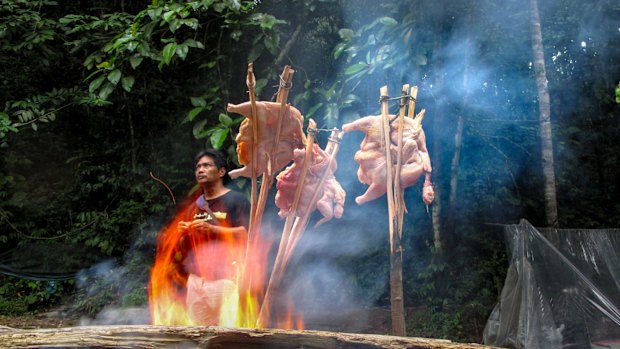
Dinner cooking at camp after a day's trekking in the Gunung Leuser National Park.Credit: Penny Stephens
In Ketambe, on the fringes of the jungle, we stay at the Wisma Cinta Alam guest house, the last one on the left out of town. But there is no town – no ATM, no money-changer, no shops. There are maybe half a dozen guesthouses for the orang-utan travellers and a mosque, a dilapidated information centre and a football field with the appearance of a WW1 battlefield, and that's all.
An excellent guide named Johan Sahbudin owns Wisma Cinta Alam with his family. He has a small team of guides with him including his brother and son. The huts are basic; the food, cooked by women of the extended family, is pretty good. There is no beer unless you know who to ask. All the Sumatrans carry a pack of cards with them. There were few other trekkers around when we were here, maybe one or two other groups.
The jungle canopy surrounds the guesthouses high up on two sides. The Alas runs fast and very shallow at the foot of the property. We needed to get in it straight away or as quickly as possible after the epic drive and the only way to do it is to lie prone in a gap in the rocks, head facing upstream, and let the clear water race over, clean (we think), fast, fresh, like a bloodstream.
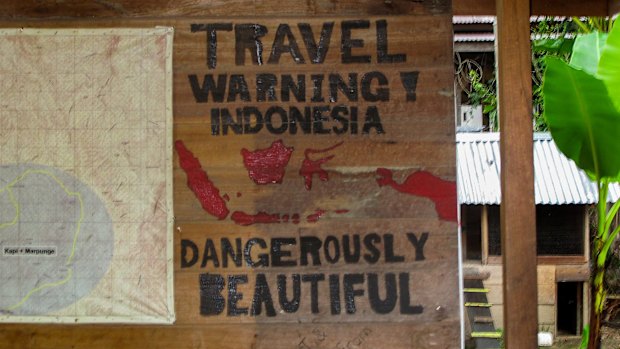
Wisma Cinta Alam guesthouse belonging to Johan and his family in the village of Ketambe, beside Gunung Leuser National Park, Sumatra.Credit: Penny Stephens
We spend a few days here on either side of the trekking. The surroundings are dramatic and charged, and watching the weather shift is an actual spectator sport. Your phone won't work. Credit cards can be a problem, especially VISA. The afternoon storms are just terrific and then when it gets dark all manner of bats come out looking for light sources. Our sons learnt to catch eels and also learnt to eat fried eel. There is electricity in the huts but that's about all. After the trekking we came back here for a few days and went rafting on the Alas with the same guides.
But first, we trek. We get into our full regalia with small backpacks and walk from the guest houses up the road for about a kilometre early one morning and then simply leave the road and walk up a steep jungle track. And that is it, we are in the jungle for the next 36 hours. I'm not sure if I expected there to be a gate or something, or a sign.
We are all wearing long but very light tan pants and light coloured shirts with long sleeves. The orang-utans are scared of bright colours, especially orange, red and black and sure enough the next day when we are in an awesome spot looking at a family of the wondrous creatures building nests some Germans tramp in wearing orange, red and black and the apes vanish.
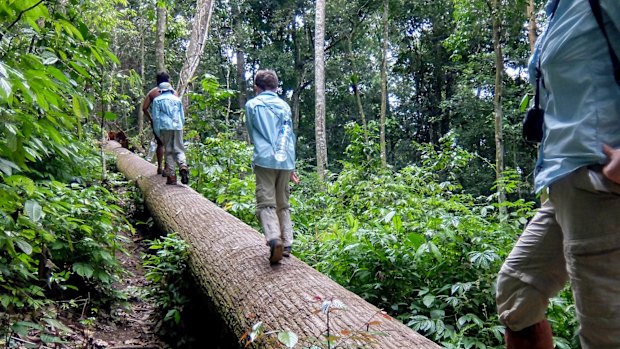
Trekking in the Gunung Leuser National Park with Johan and Udin.Credit: Penny Stephens
We have leech socks on over the top of our shoes and socks and pants up to about half way up the shin. These stop the leeches crawling in your socks and eating your feet; very handy. Hence also the long pants and long sleeves. The pants especially ended covered in splotches of blood from the leeches, which are unavoidable and a bit gross but really not too bad. Just pull them off. If they've drunk enough of your blood they will fall off anyway. Vampiric little beasties.
You carry a little bit in yourself like towels and washers and maybe dry socks and a dry t-shirt, and some shorts. A sarong, a toothbrush. The guides carry in the rest; food, clear plastic sheeting to make tents, big knives as in huge knives, woks. There's a couple of camping spots beside the river in the forest where you sleep and eat and rest between treks.
We walk and climb. The jungle is unbelievably thick. You're filed behind the guide, weaving up and down and through and under. Our guide Udin, Johan's brother, has two blokes with him to carry stuff. Everything is wet. The mud is sometimes ankle deep. You walk and you walk. The guides had made straps for our water bottles so we could wear them like packs. Spiders, snakes, who knows? Birds everywhere, including toucans. Bizarre noises. Incredible mosses. Lots of monkeys: white and black gibbons, thomas leaf monkeys. No tigers or elephants are spotted, but they do live here. There are 700 different species of animals in the Gunung Leuser including 320 types of birds.
What happens is the guide walks ahead and when he hears or sees something, beckons you to stop, and then beckons you in towards him. You can trek and trek and never see an orang-utan, that is both the beauty and the curse of the thing. On our second day we are lucky. The jungle track leads around a sort of natural bowl with a stand of very tall trees in the middle. And up there, to the left, is a mother and her babies. The mother is making a nest out of branches and leaves; they nest in the hottest part of the day. She is perhaps twenty metres up. We had brought some small binoculars with us. Udin climbs halfway up a tree to get a better look.
It is beautiful, and serene. We see quite a few more over the two days but this is the best spotting session and we stand firm for maybe an hour just checking them out as they check us out and get on with their nesting. You see this and you think: I'm never going to a zoo again.
You trek for a few hours then you trek back to the camp, rest and eat and swim in the beautiful cool river, deeper up here in the highlands, deep enough to dive off rocks, and then trek again. The guides make fires and cook chickens, they make rice, they make all kinds of things. They make tents out of branches and that clear plastic sheeting and overnight the unholiest Sumatran storm blew through and not a drop enters our tent. Not a drop.
However. I wake with a weird sensation in my throat in the middle of the night. The four of us are in the tent, the others are fast asleep and I feel like I need to cough something out. Nothing happens. I sit up and hack, nothing happens. Then I tasted blood and felt the thing move and felt a tickle on the back of my throat down near the base of my tongue. I grab it and pull and it stuck fast and then comes off and my mouth is filled with streams of more blood. I feel it on my finger all slimy like a slug and throw it away, and when I wake in the morning I see the dead leech stuck in a congealed puddle of blood on the plastic sheeting near where I lay, like a weird, miniature crime scene. To be honest I feel quite proud. The whole experience in the jungle is unique.
TRIP NOTES
MORE INFORMATION
www.orangutan.org.au/Projects/sumatran-orangutan-ecotourism
www.smartraveller.gov.au/countries/indonesia
GETTING THERE
Jetstar flies from Singapore to Medan, Sumatra. There are also flights from Australia, via Singapore, Kuala Lumpur and Jakarta.
Round-trip by minivan from Medan Airport to the Wisma Cinta Alam guesthouse at Ketambe is $100 each way, paid in cash and organised through the guesthouse.
STAYING THERE
The Wisma Cinta Alam guesthouse trip including accommodation, food and trekking, for four people costs $500. There are numerous eco-tourism guesthouses in Ketambe.
See www.schaik.com/track/wisma/cinta_alam.html
SEE + DO
Jungle trekking and rafting are the only things to do. Also, depending on the weather and the state of the roads, you might have to go all the way back to Medan in order to get anywhere else in northern sumatra. The north-west coast of Sumatra is one of the world's foremost surfing destinations and Banda Aceh on the northern coast, site of the 2004 tsunami, is extraordinary.
Chris Johnston and family travelled at their own expense.
Sign up for the Traveller Deals newsletter
Get exclusive travel deals delivered straight to your inbox. Sign up now.